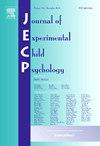Episodic future thinking and delay of gratification in children: An individual differences study
IF 1.8
2区 心理学
Q3 PSYCHOLOGY, DEVELOPMENTAL
引用次数: 0
Abstract
Unlike studies with adolescents and adults, studies with children have yet to uncover a link between episodic future thinking (EFT) and delay of gratification (DoG) and EFT cueing has not been shown to enhance children’s DoG. Understanding developmental patterns requires better understanding of the processes underlying children’s DoG performance. This study examined whether individual differences predicted 8–11-year-olds’ (53% M) performance on two separate DoG tasks, each with or without EFT cueing: a delay choice task with real rewards and a delay discounting task with hypothetical monetary rewards. It also examined whether these measures predicted children’s ability to benefit from EFT cueing. The children were from Ireland, primarily White, and ranged from marginally below average to above average SES. In analyses controlling for age and general verbal ability, none of our variables predicted the difference in performance between the uncued and EFT-cued versions of either task. Positive contemplation emotion, reflecting the extent to which a child takes pleasure from anticipating positive future events, was the sole significant predictor of performance on a delay choice task with EFT cues, controlling for age and verbal ability. For the delay discounting task, EFT ability, working memory and a more proactive attentional control style were all significant predictors of performance on an EFT-cued version of the task, but not on an uncued version. Engaging in EFT cueing seems to be effortful for children, and greater cognitive resources may be needed to buffer against the cognitive load associated with future thinking cues in delay discounting tasks.
儿童情景未来思维与延迟满足:个体差异研究
与对青少年和成人的研究不同,对儿童的研究尚未发现情景未来思维(EFT)和延迟满足(DoG)之间的联系,而EFT线索也未被证明能增强儿童的延迟满足。理解发展模式需要更好地理解儿童DoG表现背后的过程。这项研究考察了个体差异是否能预测8 - 11岁儿童(53% M)在两个独立的DoG任务中的表现,每个任务都有或没有EFT提示:一个有真实奖励的延迟选择任务和一个有假设货币奖励的延迟折扣任务。它还研究了这些指标是否能预测儿童从EFT提示中获益的能力。这些孩子来自爱尔兰,主要是白人,他们的社会地位从略低于平均水平到高于平均水平。在控制年龄和一般语言能力的分析中,我们的变量都不能预测未提示和有eft提示的两种任务之间的表现差异。积极的沉思情绪,反映了孩子从预期积极的未来事件中获得快乐的程度,是在EFT提示下延迟选择任务中表现的唯一重要预测因素,控制了年龄和语言能力。对于延迟折扣任务,EFT能力、工作记忆和更主动的注意控制风格都是EFT提示版本的任务表现的显著预测因子,但在未提示版本中没有。参与EFT提示对儿童来说似乎很费力,在延迟折扣任务中,可能需要更多的认知资源来缓冲与未来思维线索相关的认知负荷。
本文章由计算机程序翻译,如有差异,请以英文原文为准。
求助全文
约1分钟内获得全文
求助全文
来源期刊

Journal of Experimental Child Psychology
Multiple-
CiteScore
4.50
自引率
7.70%
发文量
190
期刊介绍:
The Journal of Experimental Child Psychology is an excellent source of information concerning all aspects of the development of children. It includes empirical psychological research on cognitive, social/emotional, and physical development. In addition, the journal periodically publishes Special Topic issues.
 求助内容:
求助内容: 应助结果提醒方式:
应助结果提醒方式:


